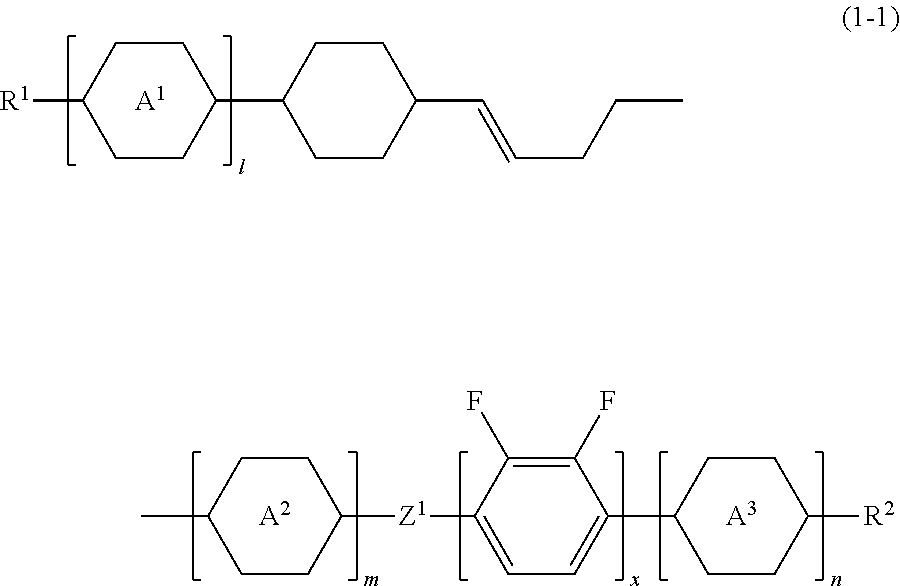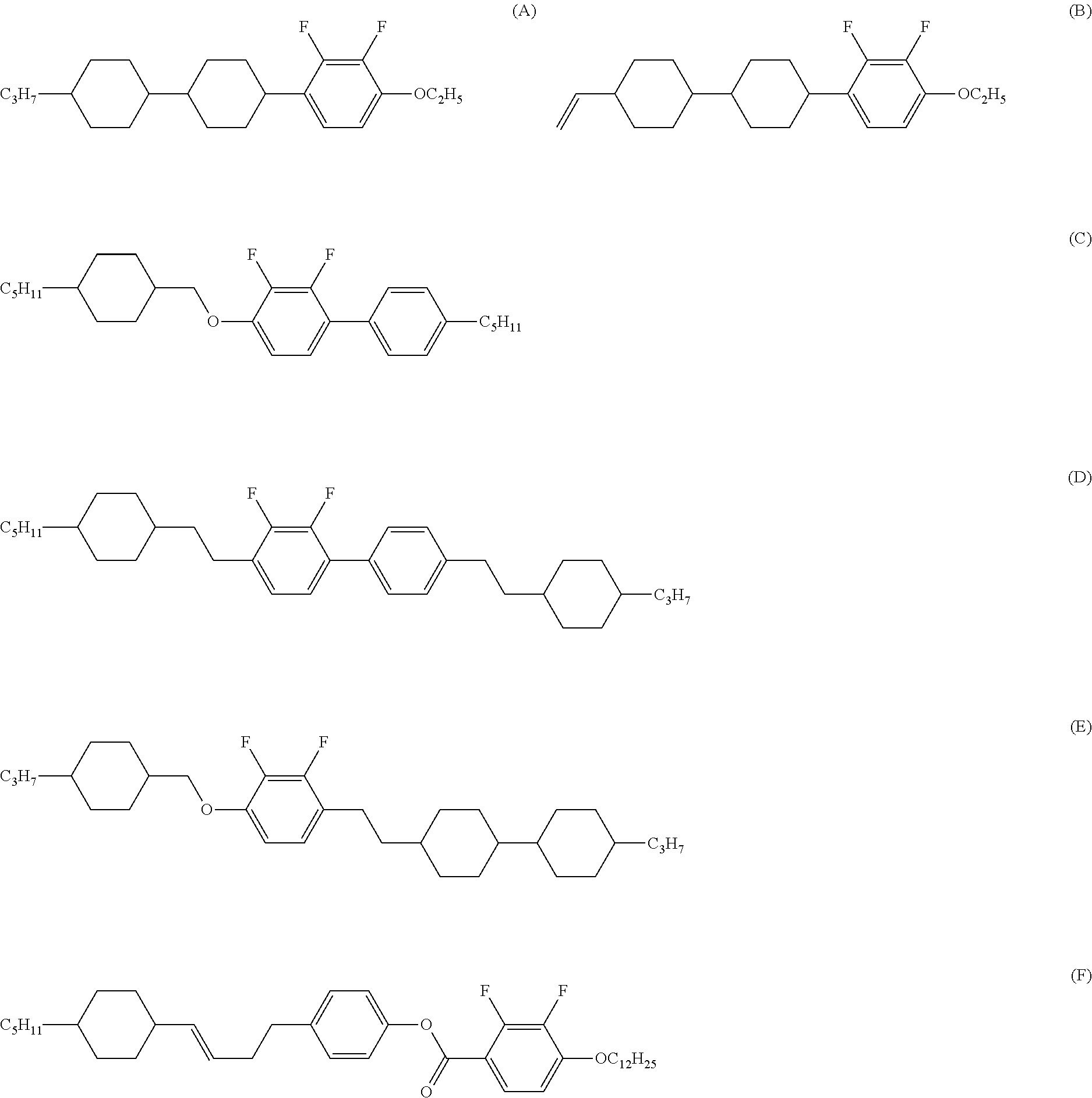Liquid crystal compound having butene-bonding group, liquid crystal composition and liquid crystal display device
a liquid crystal compound and butene bonding technology, which is applied in the preparation of organic compounds, chemistry apparatus and processes, and organic chemistry, etc., can solve the problems of compound having tn mode and stn mode, and compound has a small optical anisotropy, etc., to achieve high clearing point, small viscosity, and high heat resistance.
- Summary
- Abstract
- Description
- Claims
- Application Information
AI Technical Summary
Benefits of technology
Problems solved by technology
Method used
Image
Examples
preparation example
1-3-2. Preparation Example
[0145]
[0146]An example of a method for preparing compound (1-1) is described below. First, compound (b2) is obtained by, allowing a benzaldehyde (b1) to react with ethyl diethylphosphonoacetate in the presence of sodium ethoxide and performing a hydrogenation reaction in the presence of a catalyst such as Pd / C. Subsequently, compound (b3) is obtained by reducing compound (b2) with lithium aluminum hydride or the like. Subsequently, compound (b4) is obtained by brominating by allowing compound (b3) to react with carbon tetrabromide and triphenylphosphine. Subsequently, compound (b5) is obtained by allowing compound (b4) to react with triphenylphosphine.
[0147]Mixture of a compound (b5) obtained by a process described above and an aldehyde derivative (b6) is reacted by witting reaction via phosphorus ylide in the presence of a base such as potassium t-butoxide (t-BuOK), and then isomerized in the presence of both sodium benzenesulfonate and hydrochloric acid, ...
example 1
Synthesis of Compound (No. 2)
[0207]
First Step
[0208]Into 100 mL of THF, 1.7 g of lithium aluminum hydride was suspended. To the suspension, 9.6 g of compound (s13) was added dropwise in the temperature range of −20° C. to −10° C., and the resulting mixture was further stirred in the temperature range for 2 hours. After confirming reaction completion by GC analysis, ethyl acetate and a saturated ammonia aqueous solution were added sequentially to the reaction liquid under ice cooling, and a precipitate was removed by Celite filtration. The resulting filtrate was extracted by ethyl acetate. The resulting organic layer was sequentially washed with water and saturated brine, and dried over anhydrous magnesium sulfate. The resulting residue was further purified by recrystallization from heptane and 9.4 g of compound (s14) was obtained. A yield of compound (s14) based on compound (s13) was 97.0%.
Second Step
[0209]Into 100 mL of methylene chloride, 9.4 g of compound (s14) and 17.1 g of triph...
example 2
[0216]Various compounds were prepared using corresponding starting materials according to the techniques described in Example 1, and confirmed they are target compounds.
Compound (No. 52)
[0217]
[0218]1H-NMR (δ ppm; CDCl3): 7.41 (dd, 2H), 7.24 (d, 2H), 7.08 (td, 1H), 6.78 (td, 1H), 5.41 (m, 2H), 4.15 (q, 2H), 2.70 (t, 2H), 2.32 (m, 2H), 1.85 (m, 1H), 1.75 (m, 4H), 1.48 (t, 3H), 1.29 (m, 2H), 1.11 (m, 7H), 0.90 (t, 3H).
[0219]Physical properties of compound (No. 52) were as described below.
[0220]Transition temperature: C 84.0 N 136.3 I.
[0221]TNI=135.9° C.; Δn=0.186; Δ∈=−4.58; η=45.6 mPa·s.
Compound (No. 63)
[0222]
[0223]1H-NMR (δ ppm; CDCl3): 6.84 (m, 2H), 5.35 (m, 2H), 2.80 (t, 1H), 2.67 (t, 2H), 2.25 (q, 2H), 1.85 (d, 5H), 1.72 (d, 4H), 1.66 (d, 2H), 1.45 (q, 2H), 1.40-1.25 (m, 4H), 1.24-0.96 (m, 8H), 0.87 (m, 8H).
[0224]Physical properties of compound (No. 63) were as described below.
[0225]Transition temperature: C 41.6 N 92.6 I.
[0226]TNI=92.6° C.; Δn=0.101; Δ∈=−2.32; η=26.3 mPa·s.
Compoun...
PUM
| Property | Measurement | Unit |
|---|---|---|
| temperature | aaaaa | aaaaa |
| temperature | aaaaa | aaaaa |
| transition temperature | aaaaa | aaaaa |
Abstract
Description
Claims
Application Information
 Login to View More
Login to View More - R&D
- Intellectual Property
- Life Sciences
- Materials
- Tech Scout
- Unparalleled Data Quality
- Higher Quality Content
- 60% Fewer Hallucinations
Browse by: Latest US Patents, China's latest patents, Technical Efficacy Thesaurus, Application Domain, Technology Topic, Popular Technical Reports.
© 2025 PatSnap. All rights reserved.Legal|Privacy policy|Modern Slavery Act Transparency Statement|Sitemap|About US| Contact US: help@patsnap.com



